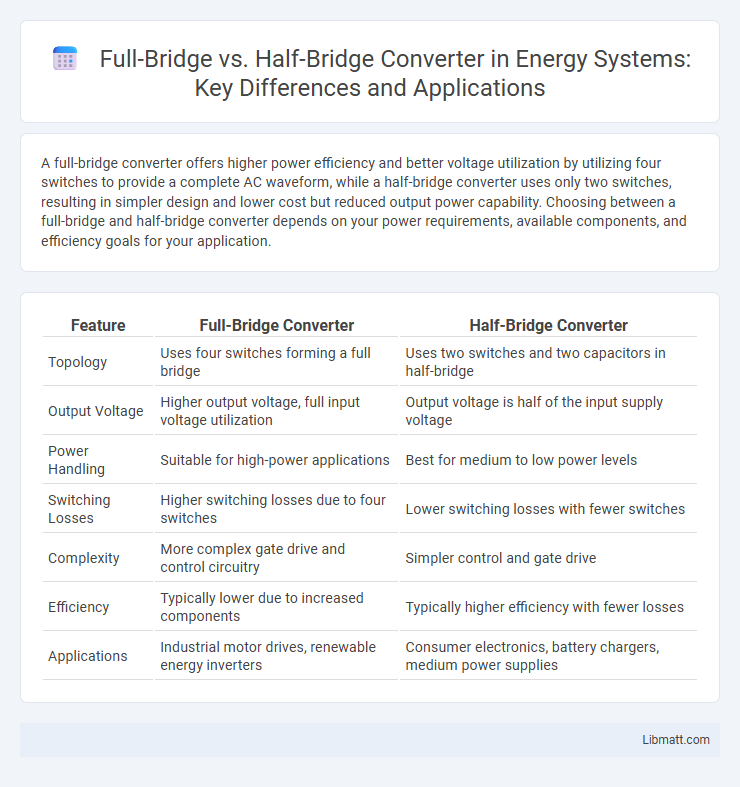A full-bridge converter offers higher power efficiency and better voltage utilization by utilizing four switches to provide a complete AC waveform, while a half-bridge converter uses only two switches, resulting in simpler design and lower cost but reduced output power capability. Choosing between a full-bridge and half-bridge converter depends on your power requirements, available components, and efficiency goals for your application.
Table of Comparison
| Feature | Full-Bridge Converter | Half-Bridge Converter |
|---|---|---|
| Topology | Uses four switches forming a full bridge | Uses two switches and two capacitors in half-bridge |
| Output Voltage | Higher output voltage, full input voltage utilization | Output voltage is half of the input supply voltage |
| Power Handling | Suitable for high-power applications | Best for medium to low power levels |
| Switching Losses | Higher switching losses due to four switches | Lower switching losses with fewer switches |
| Complexity | More complex gate drive and control circuitry | Simpler control and gate drive |
| Efficiency | Typically lower due to increased components | Typically higher efficiency with fewer losses |
| Applications | Industrial motor drives, renewable energy inverters | Consumer electronics, battery chargers, medium power supplies |
Introduction to Power Converters
Power converters are essential devices in electrical engineering that transform electrical energy from one form to another, optimizing voltage and current levels for various applications. Full-bridge converters utilize four switches arranged in an H-bridge configuration, enabling efficient bidirectional power flow and higher output voltage capabilities. Half-bridge converters, consisting of two switches and capacitors, offer simpler designs with lower component counts but generally provide lower power ratings and efficiency compared to full-bridge topologies.
Overview of Full-Bridge Converter
A Full-Bridge Converter uses four switches arranged in an H-bridge configuration to efficiently convert DC input voltage to a controlled AC output, allowing bidirectional current flow. It is widely preferred in high-power applications due to its ability to provide higher voltage output and better transformer utilization compared to half-bridge converters. You benefit from improved efficiency and reduced voltage stress on each switch, making it ideal for demanding power electronics systems.
Overview of Half-Bridge Converter
The Half-Bridge Converter is a popular DC-DC converter topology that uses two switches and two capacitors to efficiently step up or down voltage levels with a balanced voltage distribution. It offers simplified control and reduced component stress compared to full-bridge converters, making it ideal for medium power applications. Your choice of a Half-Bridge Converter can enhance system efficiency and reduce cost in designs requiring moderate power conversion.
Key Differences Between Full-Bridge and Half-Bridge
Full-bridge converters use four switches to provide better power handling and higher output voltage compared to half-bridge converters, which use only two switches and two capacitors for a simpler, cost-effective design. The full-bridge topology enables bidirectional power flow and higher efficiency in high-power applications, while half-bridge converters are preferred for medium power levels due to lower component count and reduced complexity. Your choice depends on the power requirements, cost constraints, and desired efficiency of your power conversion system.
Circuit Topology Comparison
Full-bridge converters utilize four switches arranged in an H-bridge configuration, allowing bidirectional current flow and higher power handling capabilities compared to half-bridge converters, which use only two switches and require split capacitors for voltage balancing. The full-bridge topology provides better efficiency and reduced voltage stress on each switch, improving reliability for high-power applications. Your choice between full-bridge and half-bridge converters depends on power requirements, circuit complexity, and efficiency needs.
Efficiency and Power Handling
Full-bridge converters deliver higher efficiency and superior power handling compared to half-bridge converters due to their ability to utilize the entire input voltage, reducing voltage stress on components. Your choice of a full-bridge topology suits high-power applications where efficiency maximization and minimal conduction losses are critical. Half-bridge converters, while simpler and cost-effective, are typically preferred for moderate power levels with slightly lower efficiency and power density.
Applications of Full-Bridge Converters
Full-bridge converters are widely used in high-power applications such as industrial motor drives, renewable energy systems, and uninterruptible power supplies (UPS) due to their ability to provide higher output power and more efficient voltage regulation. These converters support bidirectional power flow, making them ideal for battery charging and regenerative braking in electric vehicles and energy storage systems. Your selection of a full-bridge converter enhances system reliability and efficiency in demanding power electronics environments.
Applications of Half-Bridge Converters
Half-bridge converters are widely used in medium-power applications such as power supplies for industrial equipment, telecom systems, and battery chargers due to their efficient voltage regulation and simpler design compared to full-bridge converters. Their ability to provide good isolation and reduced component stress makes them ideal for applications requiring moderate power levels and cost-effective solutions. When selecting a converter for your project, consider half-bridge topologies for reliable performance in systems where power demands do not exceed their operational limits.
Advantages and Disadvantages
Full-bridge converters offer higher efficiency and better power handling due to their ability to utilize both halves of the input waveform, making them ideal for high-power applications. However, they require more complex control circuitry and higher component count, leading to increased cost and design complexity. Half-bridge converters provide simpler design and lower component costs with good efficiency for medium power levels but suffer from reduced output voltage range and potentially higher voltage stress on components.
Choosing the Right Converter for Your Application
Choosing the right converter depends on power requirements, efficiency, and complexity of the application. Full-bridge converters are ideal for high-power applications due to their ability to deliver higher output voltage and current with improved efficiency. Half-bridge converters offer a simpler design with fewer components, making them suitable for moderately powered systems where cost and size are critical factors.
Full-Bridge vs Half-Bridge Converter Infographic

 libmatt.com
libmatt.com